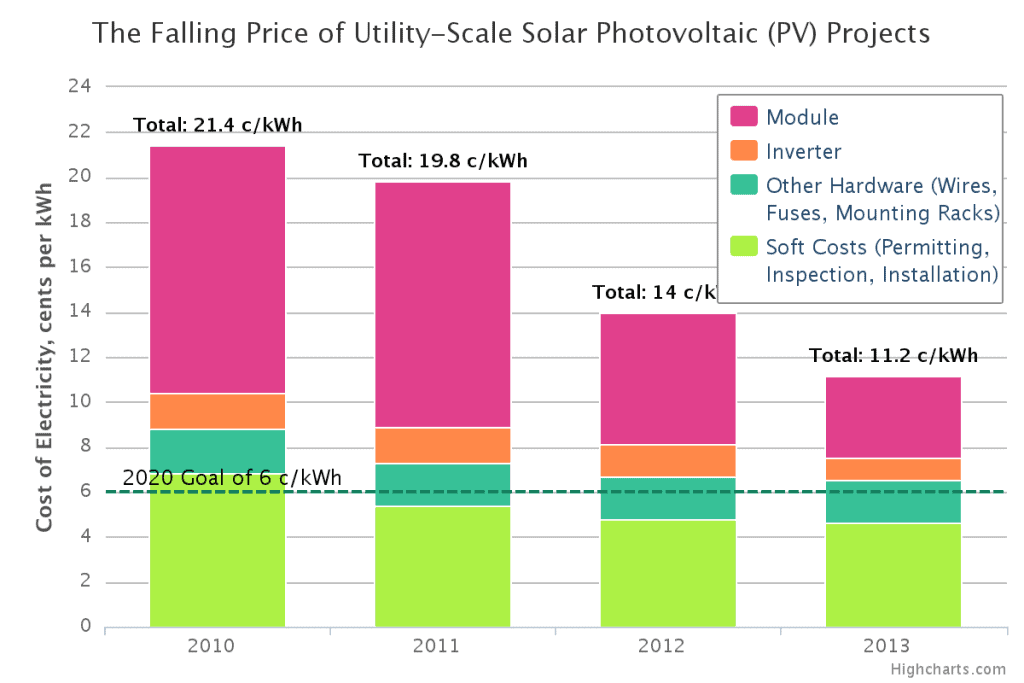A few days ago, India’s Energy Minister Piyush Goyal announced that solar energy became cheaper to produce than coal-powered, costing roughly 6 US cents/kWh. Now, it’s become even cheaper: the Dubai Electricity and Water Authority (DEWA) received the lowest ever asking price for solar energy, at 2.9 cents/kWh.

“Dubai Electricity and Water Authority (DEWA) has received 5 bids from international organisations for the third phase of the Mohammed bin Rashid Al Maktoum Solar Park,” said HE Saeed Mohammed AlTayer, MD & CEO of DEWA. “The lowest recorded bid at the opening of the envelopes was US 2.99 cents per kilowatt hour. The next step in the bidding process will review the technical and commercial aspects of the bids to select the best one.”
In the U.S., utility-scale solar projects churned out energy for an average price of US$ 0.05/kWh, factoring in subsidies and incentives, in 2014. Since then, there has been a huge drop in production costs: in 2015, Dubai signed a deal for a fixed US$ 0.058/kWh over 25 years. Austin, Texas, saw a total of almost 1,300 MW of energy in bids of under US$ 0.04/kWh last summer, and this month Enel Green agreed to sell power to Mexico and Morroco at US$ 0.036 and US$ 0.03 per kilowatt-hour respectively. In under sixteen months, the price of solar has dropped down to half — even lower when you consider that these bids aren’t subsidized.

The Office of Energy Efficiency and Renewable Energy reported that in November 2015, four years into the decade-long SunShot Initiative, the solar industry is about 70% of the way to achieving the target cost of US$ 0.06/kWh for utility-scale PV (based on 2010 baseline figures.) A cost target that will make solar-generated power be fully cost-competitive with traditional energy sources, they believe.
Now, a consortium led by Abdul Latif Jameel of Saudi Arabia, Fotowatio Renewable Ventures (FRV) of Spain, and Masdar of the UAE said they could produce solar energy at an even lower price of US$ 0.029 cents/kWh unsubsidized — the lowest asking price for solar in the world.
“The consortium’s 2.99$c/kWh bid is 18% lower than the 3.65$c/kWh bid submitted by JinkoSolar of China, and also drastically undercut the 3.95$c/kWh tariff submitted by an Acwa Power-First Solar consortium,” writes Ian Clover of PV-Magazine. “The two other bids were for 4.382$c/kWh – submitted by U.K./French firm Engie ad Japan’S Marubeni – and 4.482$c/kWh, submitted by a consortium comprised of France’s EDF and Qatar’s Nebras.”
As the biggest expense for solar power plants is the initial construction costs, some speculate that Masdar had access to financing through the wealthy emirate of Abu Dhabi that commercial banks, the primary source of capital for his competitors, couldn’t match in cost. Dr. Moritz Borgmann, a partner at clean energy advisory company Apricum, believes that Jinko Solar, whose bid stood at $0.0365/kWh, and Acwa Power, at US$0.0395/kWh, were more realistic in their bids.
[button url=”http://understandsolar.com/signup/?lead_source=zmescience&tracking_code=dubai_solar” postid=”” style=”btn-success” size=”btn-lg” target=”_blank” fullwidth=”true”]Find out how much solar energy costs in your area[/button]
Even so, that’s a massive drop in price. And although Dubai is probably the sunniest place I can think of right now, we can expect solar to get cheaper, across the board, as time goes by; Ramez Naam, author of “How Cheap can Solar Get?” said:
“If solar electricity continues its current learning rate, by the time solar capacity triples to 600GW (by 2020 or 2021, as a rough estimate), we should see unsubsidized solar prices of roughly 4.5 c / kwh for very sunny places (the US southwest, the Middle East, Australia, parts of India, parts of Latin America), ranging up to 6.5 c / kwh for more moderately sunny areas (almost all of India, large swaths of the US and China, southern and central Europe, almost all of Latin America).”
“And beyond that, by the time solar scale has doubled 4 more times, to the equivalent of 16% of today’s electricity demand (and somewhat less of future demand), we should see solar at 3 cents per kwh in the sunniest areas, and 4.5 cents per kwh in moderately sunny areas.”






